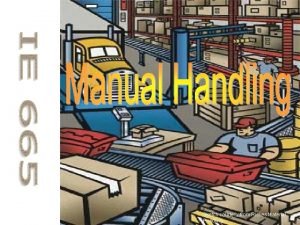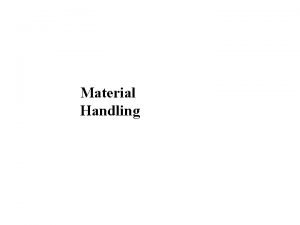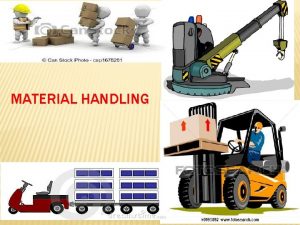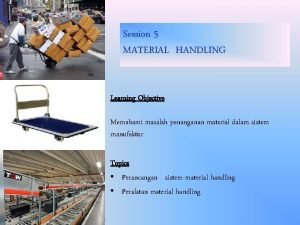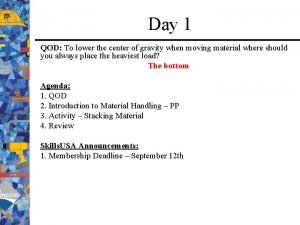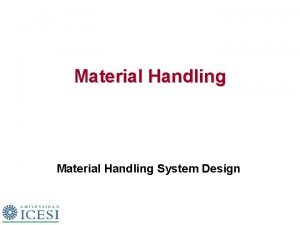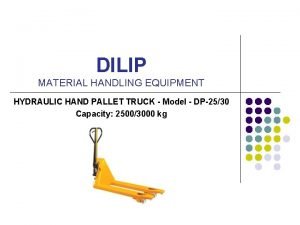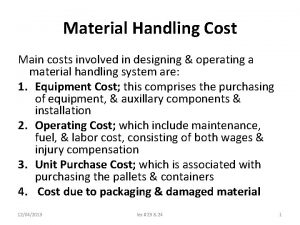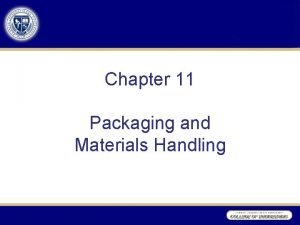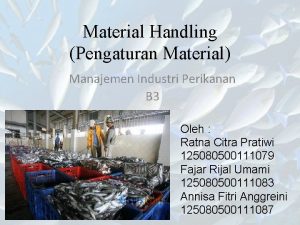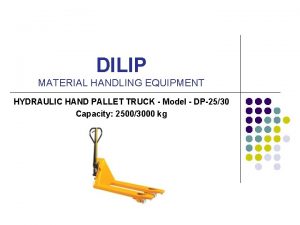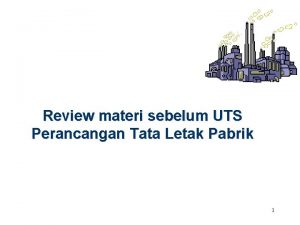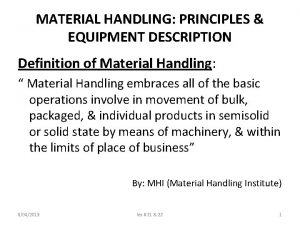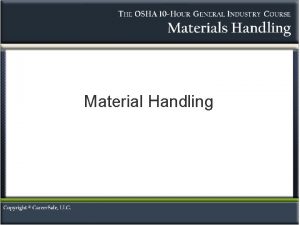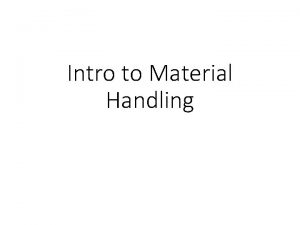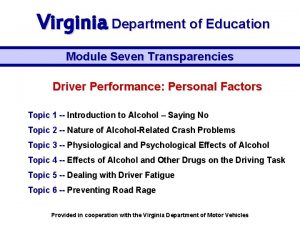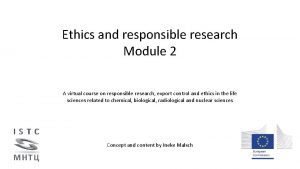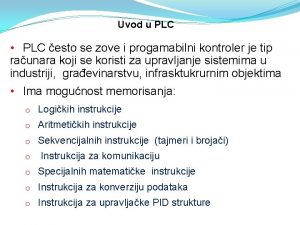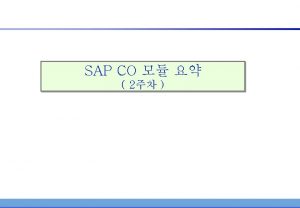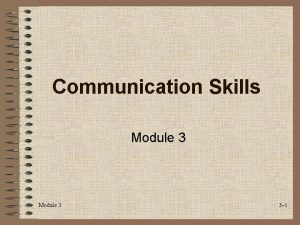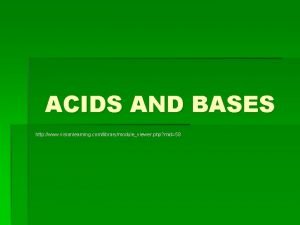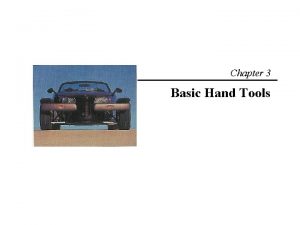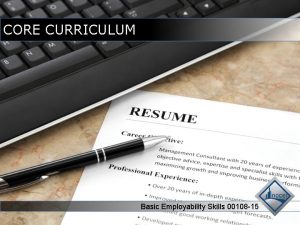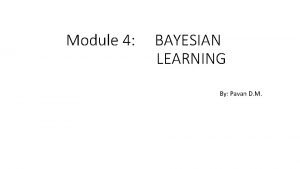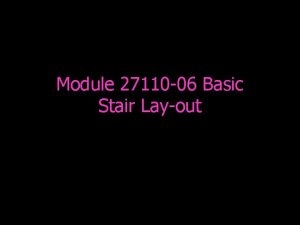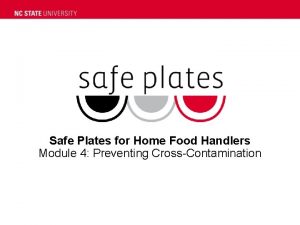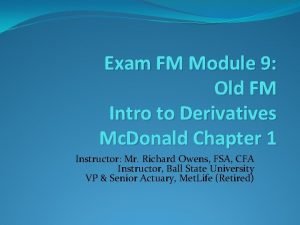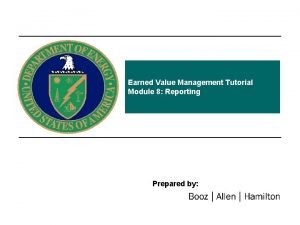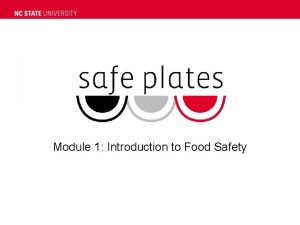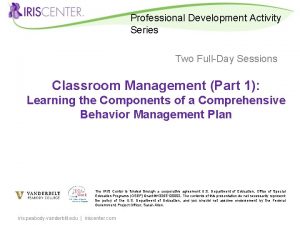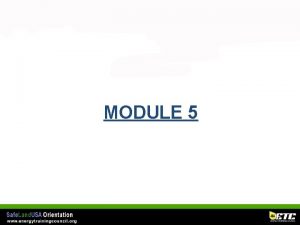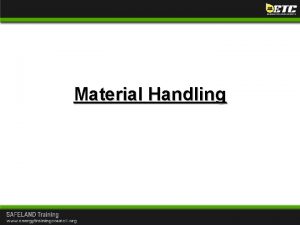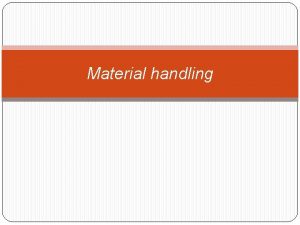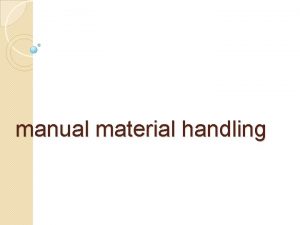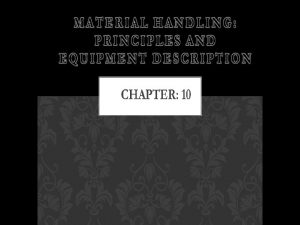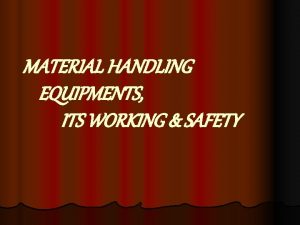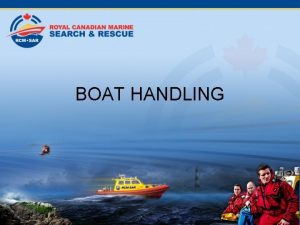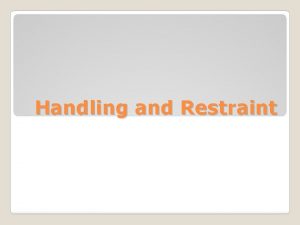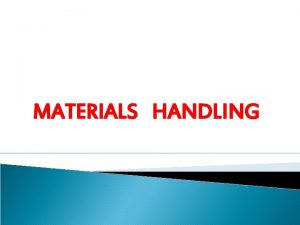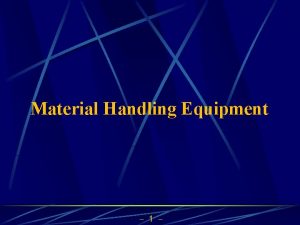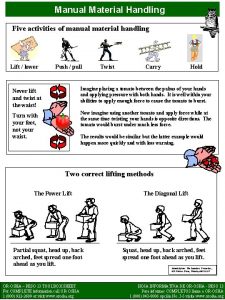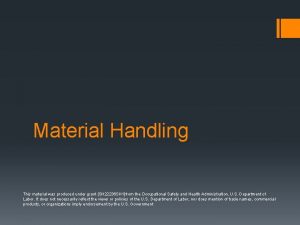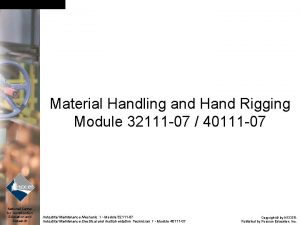MODULE 5 Material Handling Material Handling Material handling



















































































- Slides: 83

MODULE 5

Material Handling

Material Handling Material handling equipment: all equipment that relates to the movement, storage, control and protection of materials, goods and products. – Aerial lifts – Bulk material handlers – Gin poles - Forklifts - Cranes - Cherry pickers

Material Handling • Before using any type of equipment it is required that you be: – Trained on that specific type of equipment. – Certified – Authorized • A pre-operation inspection shall also be conducted before starting the equipment. – Inspections must take place at least daily at the beginning of each shift. – Unsafe equipment must be removed from service and reporter

Material Handling – Any powered industrial truck not in safe operating condition shall be removed from service. All repairs shall be made by authorized personnel. (29 CFR 1910. 178 (q)(1)) – Defects when found must be immediately reported and corrected. (29 CFR 1910. 178 (q)(1))

Material Handling • Forklift safety – Driving characteristics are different then a car. – The center of gravity can be moved by: • • • Traveling with an elevated load Load too heavy Fast turns A hill or incline Starting or stopping too fast Jerky operation of the hydraulics

Material Handling • Forklift safety – – – – No unauthorized drivers No daydreaming Poor forward visibility Forks or loads kept low Operate at reasonable speed, no speeding No Horseplay Allow three truck lengths when following Assume overhead lines are energized

Material Handling • Cranes: – A lifting machine, generally equipped with a winder or wire rope drum, wire ropes or chains and sheaves that can be used to lift and lower materials and to move horizontally.

Material Handling • Types of cranes: – – – Truck mounted Side-lift Rough terrain All terrain Crawler crane

Material Handling – Rigging: • The equipment and method used in lifting, pulling, or tying down an object. – Always make sure to use rigging designed specifically for lifting. – Tag Lines: • • • Lines to keep you out of the line of fire. Used to position load Attach before load is lifted Never wrap around body parts Non-conductive poly material Clean and free of knots

Material Handling • Hand tools – – Use proper tool for the job Wear correct PPE Inspect prior to use Never use broken or damaged hand tools • Power tools – Properly insulated and grounded – No alteration or modification – Never remove/modify guards

Material Handling • Cheater Bar / Pipe – An engineer designed and tested handle extension used to free items that are hard to remove with a ratchet or wrench alone or to operate valves. – NOT A HOMEMADE DEVICE – Not recommended, used only as a last resort – Can’t be more then twice the length of wrench or handle

Material Handling • Problems in using a handle extension: – If the component frees suddenly the worker can become a projectile that is propelled. – The cheater bar itself can become part of a catapult with the worker in the line of fire. – Use of such items can damage the component. – Falls, impacts, punctures and other injuries can occur from improper use.

Material Handling Back Injury Prevention – The back is critical in daily operations. It is used in every aspect of life. – After suffering one back injury, you are much more likely to experience another one later on. – More than 1 million workers suffer back injuries each year, accounting for 1/5 of all workplace injuries or illnesses.

Material Handling • Why back injuries occur: – – – – Poor physical condition Poor posture Extra weight Stress Heavy lifting Twisting at the waist while lifting Lifting, carrying or working in odd positions Sitting or standing too long in one position

Material Handling • It takes 10 lbs. of pressure to lift a 10 lb. object. • When you add in the 105 lbs. of an average human’s upper torso, lifting a 10 lb. objects put 1, 150 lbs. of pressure on the human back.

Material Handling • Alternatives to Lifting – – – Use cranes, hoists and lift tables Place objects up off the floor or ground Raise/lower work surfaces when possible Use carts and dollies to move objects Get a partner to help you lift Reduce the amount of weight lifted

Material Handling • Proper Lifting Techniques – Bend your knees – Take a balanced stance – Squat down to lift, keeping your heels off the floor.

Material Handling • Proper Lifting Techniques – Get a firm grip on the load. – Lift gradually keeping the load close to your body. – Change directions by pointing your feet in the direction you want to go.

Material Handling • Proper Lifting Techniques – Avoid twisting at your waist while carrying a load. – When you put a load down, use these same guidelines in reverse.

Walking-Working Surfaces

Walking-Working Surfaces • Slips, trips and falls can happen in any part of the workplace, inside or outdoors. • Slips and trips often result in falls and more serious outcomes, including disabling injuries and even death. • The cost to both worker and employer can be great.

Walking-Working Surfaces - Housekeeping DO – Keep aisles, walkways, stairways and escape routes free of clutter. – Clean up spills immediately. – Prevent oil accumulation on floors. – Pick up trash. – Return tools and parts to their proper areas. – Keep tools and materials away from edges of platform. – Stack tools on a flat surfaces; cross-tie them or cover them to keep in place.

Walking-Working Surfaces - Housekeeping DON’T – Leave spills for someone else to clean up. – Allow oil to build up on surfaces. – Allow trash to collect in corners, under machinery or other out of the way places. – Assume someone else sees the hazard. – Lay tools and other materials close to edges, on railings or sills.

Walking-Working Surfaces General Requirements: – Employees must be extremely cautious when working near and around: • • • Floor and wall openings Stairways Platforms Ladders and scaffolds All elevated work areas

Walking-Working Surfaces • General Requirements: – Always use handrails. – Avoid ascending and descending any climbing surface with awkward loads or without handrails. – Always have adequate lighting. – Always wear fall protection when required.

Walking-Working Surfaces • Dropped Objects: – Provide Adequate Warning: – If you are going to do work overhead warn those in the area: • • Verbally With signs Ropes Barricades

Walking-Working Surfaces Guarding: – Cover all floor openings, wall openings and holes to prevent tripping, falling or loss of tools. – Every open-sided floor or platform 4 feet or more above the adjacent floor or ground must be guarded.

Walking-Working Surfaces Guarding: – Do not use barricade tape or flagging as a temporary railing or fall restraint. – Never leave a floor opening unprotected. – Covers and/or guardrails must be provided to protect employees from hazards. – While the cover is not in place, the opening must be constantly attended.

Walking-Working Surfaces When we are talking about holes and openings, the following criteria is used: • Floor Hole: opening less than 12 inches but more than 1 inch. • Floor Opening: Opening larger than 12 inches.

Walking-Working Surfaces Scaffold Safety – Scaffolds are engineered systems used for elevated work and must be properly designed and assembled by qualified workers. – Guardrails and toeboards must be installed on all open ends and sides greater than 10 feet high. – Handrails on open ends and sides. Must be able to withstand at least 200 pounds. – Ladders or stairways must be provided for climbing onto scaffolds.

Walking-Working Surfaces Scaffold Safety – Employees shall not work on scaffolds during storms and high winds. – Slippery conditions, including ice and snow must be eliminated as soon as possible after they occur.

Walking-Working Surfaces Ladder Safety – Ladders must be inspected before each use. – Any ladder found to have defects must be repaired or tagged for destruction. – Inspect footing, rungs, steps, side rails, hinges and spreaders

Walking-Working Surfaces Ladder Safety – Maintain ladders in good condition at all times. – Maintain a 4: 1 slope – Ladders used to gain access to roofs must extend no less than 3 feet from the point of support. – Do not use make-shift ladders.

Walking-Working Surfaces Ladder Safety – Never use a ladder in the horizontal position as a work platform. – Do not leave ladder unattended. – Always face a ladder when climbing up or down. – Always maintain 3 points of contact.

Walking-Working Surfaces Ladder Safety – Carry tools in a tool belt. – Keep your body centered on the ladder – use the “belt buckle” rule. – Do not use metal ladders near electrical equipment. – One person at a time on a ladder unless specifically designed for more.

Walking-Working Surfaces Stairways and Handrails composed of: • • Steps Landings Risers Handrails Requirements for handrail on stairways • • • 4 or more risers Greater than 36 inches Depend on stairway width Provide adequate handhold Withstand at least 200 pounds of force

Walking-Working Surfaces Stairways and Handrails – Safety rules • • • Use handrails Keep clear of objects Do not block vision with loads Be alert to wet/slippery surfaces Report damaged stairways

Industrial Hygiene and Occupational Health

Industrial Hygiene and Occupational Health • Occupational health hazards are a part of working in our industry. • Through training, knowledge and an understanding of the hazards, we can work safely in these environments.

Industrial Hygiene and Occupational Health Industrial Hygiene • Industrial Hygiene is the evaluation of environmental factors through measurement of exposure intensity, exposure frequency, and duration. • A Hygienist is a person who by study, training, and experience can: anticipate, recognize, evaluate and control workplace environmental hazards.

Industrial Hygiene and Occupational Health Hazards • Air contaminates: – dusts, fumes, mists, aerosols and fibers. • Chemical agents: – solids, liquids, gases, mists, dust, fumes and vapors. • Biological hazards: – viruses, fungi, and other living organisms.

Industrial Hygiene and Occupational Health Hazards (continued) • Physical hazards: – excessive levels of ionizing and non-ionizing electromagnetic radiation, noise, vibration, illumination, and temperature. • Ergonomic hazards: – including but not limited to lifting, holding, pushing, walking, and reaching.

Industrial Hygiene and Occupational Health • Lead is a heavy metal • It can be found in pipes, cable sheaths, batteries, bullets, paint, gasoline and solder. • In certain doses, lead can be a toxic substance when absorbed into your body.

Industrial Hygiene and Occupational Health • Typical work activities which may generate lead exposure: – – – Welding Buffing Grinding Torch cutting Sand blasting on coated surfaces

Industrial Hygiene and Occupational Health • Lead is a heavy metal that can enter the body through inhalation or ingestion. • Symptoms of over-exposure: – – – Headaches Fatigue Anemia Irritability Muscle and joint pain Stomach cramps

Industrial Hygiene and Occupational Health • Benzene is an aromatic hydrocarbon that occurs naturally in petroleum crude oils and natural gas condensates. • Benzene concentrations are usually greater in lighter crude oils and condensates. • Under normal operating conditions, benzene should not be present in hazardous airborne concentrations.

Industrial Hygiene and Occupational Health Benzene • Acute health effects: – – Headache Dizziness Drowsiness Respiratory irritation • Chronic health effects: – Cancer of the blood forming organs (leukemia).

Industrial Hygiene and Occupational Health Benzene can be detected by: – Odor – aromatic, slightly sweet odor. – Physical symptoms – acute and chronic health effects. – Gas monitor – fixed monitor or personal. If you suspect a benzene spill or leak, vacate the area immediately and notify the appropriate personnel.

Industrial Hygiene and Occupational Health • Carbon Dioxide gas is formed from the combination of two elements: carbon and oxygen. • It is produced from the fermentation of liquids and breathing by humans and animals. • It cannot sustain life.

Industrial Hygiene and Occupational Health Naturally Occurring Radioactive Material (NORM) – NORM is a broad group of radioactive substances found naturally in our environment. – Crude oil, natural gas, and other substances extracted from the ground may be found to possess measurable levels of radioactivity. – Exposure occurs when the radioactive materials become airborne.

Industrial Hygiene and Occupational Health • The primary hazard is not the exposure to NORM but when these materials are taken into the body through: – Breathing – Eating – Open cuts and wounds

Occupational Health - Fibers (Man-made & Asbestos) • 29 CFR 1910. 1001 indicates that all affected personnel shall be trained in a way to ensure the employee’s understanding. • Asbestos is mainly used in fiber form. • Employees will be taught how to use respiratory protection if working in exposure areas.

Occupational Health-Fibers (Man-made & Asbestos) – A medical surveillance program will be activated if exposure to airborne concentrations of fibers or asbestos are at or above the action level and/or excursion limit. – Examinations will be performed by a licensed physician and shall include a medical work history and complete physical exam of all systems.

Occupational Health-Fibers (Man-made & Asbestos) • Air samples will be taken in the breathing zone where action level and/or excursion limits are reached.

Industrial Hygiene and Occupational Health – Organic Solvents are substances that are capable of dissolving or dispersing one or more other substances. – Many organic solvents are recognized by NIOSH as carcinogens (benzene, carbon tetrachloride, trichloroethylene).

Occupational Health-Organic Solvents • Organic Solvents • Some examples and their uses: – Methane – • Industrial settings. – Toluene – • Paint, fuel oil, cleaning agents, lacquers, and paint thinners. – 1, 1, 1 – Trichloroethane (methyl chloroform) – • Degreaser and propellant.

Occupational Health-Organic Solvents • • Avoid breathing in vapors Ventilate the area well. Wear rubber gloves when using solvents. Wash solvents from skin immediately after use.

Industrial Hygiene and Occupational Health • Mercury – Found in wastewater from oil and gas production. – Mercury can enter the body through the lungs, skin and through the digestive system. • Effects include kidney failure, respiratory failure and/or death. • Diethanolamine – Purifies gases, particularly natural gas. – Clear, colorless or pale yellow liquid.

Occupational Health-Hexavalent Chromium • Yellowish-green liquid. • Recognized as a human carcinogen. • Problematic among workers who handle chromate products and those who arc weld stainless steel.

Occupational Health-Methanol – Most commonly produced from the methane component in natural gas. Also known as wood alcohol. • • • Volatile Colorless Highly flammable Distinct odor slightly sweeter than ethanol Burns with a clear flame

Occupational Health-Nitrogen Gas (N 2) • Effective alternative used to frac shallow wells. – – Normally colorless Odorless Tasteless Non-metal gas

Industrial Hygiene and Occupational Health Crystalline Silica • Crystalline Silica is a basic component of soil, sand, granite, and many other minerals. Quartz is the most common form of silica. • Silica is used in hydraulic fracturing • When engineering and work practice controls are not feasible, respirators must be provided to workers.

Industrial Hygiene and Occupational Health Crystalline Silica • Exposure through inhalation • Silica causes silicosis which is irreversible, but preventable • Silica can also cause lung cancer and has been to linked to other diseases, such as tuberculosis, chronic obstructive pulmonary disease, and kidney and autoimmune disease

Industrial Hygiene and Occupational Health Diesel Particulate Matter (DPM) • DPM are small particles found in diesel exhaust • Short term exposure to high concentrations of DPM can cause headache, dizziness, and irritation to the eyes, nose, and throat. • Prolonged exposure to DPM can increase the risk of cardiovascular, cardiopulmonary and respiratory disease, and lung cancer

Occupational Health-Insect Bites – Stings and bites from insects are common, usually resulting in redness and swelling of the area. – Occasionally a sting can cause a life threatening reaction if you are allergic to the insect or are bitten multiple times.

Occupational Health-Insect Bites Bee/Wasp • Ensure the stinger has been removed if you are stung. • Wash area with soap and water. • Apply ice pack or cold compress. – Do not place directly on skin. • Elevate extremity.

Occupational Health-Insect Bites – Symptoms may include: • • • Pain Swelling Redness Itching Anaphylaxis • Watch for signs and symptoms other than at location of sting for at least 30 minutes. • Watch for signs of infection to show up later.

Occupational Health-Insect Bites Anaphylaxis • A severe reaction beyond the immediate area of a sting if you are allergic. • Symptoms may include: – Hives – Wheezing – Shortness of breath – Unconsciousness – Possible death

Occupational Health-Insect Bites • You can minimize your exposure to insect bites by changing your patterns of activity or behavior. • Avoid outdoor activity during dawn and dusk periods if possible. • Wear long-sleeved shirts, long pants and hats. • Use insect repellants – apply to clothing, shoes and other gear.

Occupational Health-Insect Bites • Mosquitoes • Wash bite area thoroughly with warm water and soap. • Mosquitoes can transmit serious diseases such as: – West Nile – Malaria – Yellow Fever

Occupational Health-Insect Bites Mosquitoes - Signs and symptoms of more serious infection may include: – – – Fever Severe headache Body aches Nausea/vomiting Swollen glands – – – Rash Lethargy Confusion Sensitivity to light Jaundice

Occupational Health-Insect Bites Mosquitoes • Mosquitoes select their victims by evaluating scent, exhaled carbon dioxide and the chemicals in your sweat. • Mosquitoes are more likely to bite: – – Men Those with type “O” blood Overweight individuals Those wearing dark colors

Occupational Health-Snake Bites Snakes – It is important to identify the type of snake you are dealing with. This will aid doctors in treatment if you are bitten. – Wash the wound and keep the injured area still and lower than the heart. Rattle Snake Copper Head Bull Snake

Occupational Health-Spider Bites Insects • Spiders: there are two main types to be aware of. – Black Widow – Brown Recluse or Fiddleback

Occupational Health-Spider Bites Black Widow • Call Poison Control if bitten (800 -222 -1222)

Occupational Health-Spider Bites Black Widow • Symptoms to watch for: – Dull, aching, or numbing sensation appears in 20 -40 minutes. – Muscle pain and cramps near bite within 30 -120 minutes. – Board-like rigidity of the abdomen, shoulders, and back may develop. – Pain generally peaks at 2 -3 hours.

Occupational Health-Spider Bites Brown Recluse (Fiddleback) • Call Poison Control if bitten (800 -222 -1222)

Occupational Health-Spider Bites Brown Recluse (Fiddleback) • Symptoms to watch for: – Reaction depends on the amount of venom injected and the person’s sensitivity to the venom. – Bite may feel like a pinprick or go unnoticed. – Symptoms can take 2 -8 hours to occur. – Typically small white blister surrounded by raised, reddened skin.

Occupational Health-Rabid Animals – Rabies virus travels to the brain by following the peripheral nerves. – Incubation period of the disease is usually a few months. – Once rabies reaches the central nervous system and symptoms begin to show, the infection is effectively untreatable and usually fatal within days.

Occupational Health-Rabid Animals • Symptoms: – Flu-like symptoms within 2 -12 weeks of infection. – Malaise, headache and fever, progressing to acute pain, violent movements, uncontrolled excitement, depression and hydrophobia. – Patient may experience mania and lethargy that leads to coma. – Death is usually by respiratory insufficiency.

Occupational Health-Staph – Staph symptoms may vary depending on the location and severity of the infection. – Skin infections may be passed from one family member to another. It is important to not share clothing, towels or other similar items. – Staph can survive: • Drying • Temperature extremes • High levels of salt

Occupational Health-Staph Prevention – Wash your hands – Keep wounds covered – Keep personal items personal Do your part to keep YOU healthy. 5 B
 C device module module 1
C device module module 1 Riekes material handling
Riekes material handling Potential hazards
Potential hazards Material handling and facilities planning
Material handling and facilities planning Material handling objectives
Material handling objectives Define material handling
Define material handling Prinsip material handling
Prinsip material handling To work with motorized material-handling device
To work with motorized material-handling device Unit load adalah
Unit load adalah Dilip lift truck
Dilip lift truck Material handling costs
Material handling costs Unit load principle
Unit load principle Packing learning objectives
Packing learning objectives Material handling efficiency
Material handling efficiency Manajemen industri perikanan
Manajemen industri perikanan Welding robots ppt
Welding robots ppt Dilip material handling equipments
Dilip material handling equipments Rancangan produk rancangan proses dan rancangan skedul
Rancangan produk rancangan proses dan rancangan skedul Dead weight principle in material handling
Dead weight principle in material handling Introduction of material handling
Introduction of material handling Intro to material handling
Intro to material handling Time variance
Time variance Useful and harmful
Useful and harmful Forms of pop culture
Forms of pop culture Refers to the knowledge language values customs
Refers to the knowledge language values customs Geometrical symbol
Geometrical symbol Examples of non material culture
Examples of non material culture Gestalt psychology illusions
Gestalt psychology illusions Module 5 lesson 5
Module 5 lesson 5 Arc length and sector area module 16
Arc length and sector area module 16 Module 2
Module 2 Doccom module 6
Doccom module 6 9dsmmwikhpi -site:youtube.com
9dsmmwikhpi -site:youtube.com Jewellery module in tally
Jewellery module in tally Module 47 infancy and childhood cognitive development
Module 47 infancy and childhood cognitive development Module 7 topic 3 drivers ed
Module 7 topic 3 drivers ed Jason foundation quiz answers module 2
Jason foundation quiz answers module 2 Plc ladder
Plc ladder Ssp module
Ssp module Co module
Co module Codtoc
Codtoc Patterns and sequences module quiz b
Patterns and sequences module quiz b Module 3 communication/interpersonal skills
Module 3 communication/interpersonal skills Is an extended erp module
Is an extended erp module Erp purchase module flowchart
Erp purchase module flowchart Vga toto
Vga toto Module 31
Module 31 Media and information literacy module 6
Media and information literacy module 6 Scouts module 17
Scouts module 17 Module 4 - open source software and licensing
Module 4 - open source software and licensing Www.visionlearning.com/library/module viewer.php mid=58
Www.visionlearning.com/library/module viewer.php mid=58 Module 58 trait theories
Module 58 trait theories Clean and sanitize kitchen premises module
Clean and sanitize kitchen premises module Basic tools and basic hand operations
Basic tools and basic hand operations Coordinate proof using slope and distance
Coordinate proof using slope and distance Module 2
Module 2 Module 23 sleep patterns and sleep theories
Module 23 sleep patterns and sleep theories Module 00108 exam
Module 00108 exam Pricing strategies in retail management
Pricing strategies in retail management Access module 3 maintaining a database
Access module 3 maintaining a database I hate module
I hate module Module
Module Module de supervision
Module de supervision Module 4 topic 1 assessing and managing risk
Module 4 topic 1 assessing and managing risk Basic stair layout module 9
Basic stair layout module 9 System administration module
System administration module Sample foreword of a module
Sample foreword of a module Safe plates module 4
Safe plates module 4 Linear module configurator
Linear module configurator Module 9 old and new
Module 9 old and new Dbt app
Dbt app Earned value management tutorial module 7
Earned value management tutorial module 7 Iec and bcc difference
Iec and bcc difference Revision module 1
Revision module 1 Module 1 introduction to food safety
Module 1 introduction to food safety Module in malay
Module in malay Counter module for compact fieldpoint
Counter module for compact fieldpoint Basic bible seminar module
Basic bible seminar module Aqueous solutions module
Aqueous solutions module Iris module classroom management
Iris module classroom management Module
Module Which type of ebusiness model is amazon using?
Which type of ebusiness model is amazon using? Ang pinaka demokratikong lungsod-estado ng greece
Ang pinaka demokratikong lungsod-estado ng greece University of kent student data system
University of kent student data system

